Dr. Santimukul Santra's Research

Discipline/Specialization: Polymer Chemistry
Ph.D., Synthetic polymer chemistry and organic chemistry, Indian Institute of Technology-Bombay (IIT-Bombay), Mumbai, India, 2006
M.Sc., Organic Chemistry, Banaras Hindu University (BHU), Varanasi, India, 2000
B.Sc., Chemistry, Ramakrishna Mission College-Narendrapur. University of Calcutta, India, 1998
Research website: https://www.nanotheranosticlab.com/
- Professional Experience and Areas of Specialization
- Courses Taught
- Professional Research Interests
- Lab Instruments and Facilities
- Lab Members, Activity, and Photos
- Lab Activities
- Polymeric nanotheranostics for the targeted imaging and treatment of cancers
- Novel activatable theranostic probes for the targeted optical detection, MR imaging and treatment of ovarian, lung and cervical cancer
- Polymer-coated magnetic relaxation nanosensors for detection, isolation and treatment of infectious diseases and cancer
- Polymer-coated cerium oxide nanoparticles: oxidase-like activity, nanocatalyst, medical device for the detection of chronic inflammations and cancer biomarkers
- Patents
- Publications, Presentations, Awards, and Funded Grants
Professional Experience:
2013 - Present Assistant Professor. Department of Chemistry and KPRC, Pittsburg State University, Pittsburg, Kansas, U.S.A.
2010 - 2012 Research Assistant Professor. Nanoscience Technology Center, University of Central Florida, Orlando, Florida, U.S.A.
2007 - 2009 Postdoctoral Research Associate. Nanoscience Technology Center, University of Central Florida, Orlando, Florida, U.S.A.
Areas of Specialization:
- Biodegradable hyperbranched polymer and dendrimer synthesis
- Multi-step organic synthesis of biologically active small molecules and therapeutic drugs
- Nanoscience and nanotechnology
- Nanotheranostics, immunotherapy and nanobioimaging
- Targeted drug delivery and cancer therapy
- Early detection of infectious diseases and neurodegenerative disorders
- CHEM 720 Advanced Polymers
- CHEM 685 Polymers in Nanotechnology
- CHEM 216 Gen. Chem. I Lab
- CHEM 626 Polymer Chemistry Lab
- CHEM 326 Organic Chemistry I Lab
Nanotechnology-based pharmaceutical theranostics for targeted cancer therapy, neurodegenerative disorders, and nanosensors for the detection of single cancer cells in blood circulations / infectious diseases, optical / MRI / X-ray CT imaging of malignant tumors, activatable nanotheranostics for the targeted imaging and treatment of cancers.
- Pharmaceutical nanotheranostics for targeted detection, non-invasive imaging and treatment of malignant carcinomas
- Combination therapy: Co-synergistic effect of cytotoxic drugs and peptides to trigger malignant tumor death
- Cancer inhibitor therapy: Targeting Ras mutant tumors and neurodegenerative disorders
- Medicinal chemistry: Design and synthesis of activatable pro-theranostics: prodrugs, optical probes / MRI / X-ray CT contrast agents for detection and treatment of diseases
- Aptamer Nanobiotechnology: Receptor / Nucleolin targeting using small molecule / Aptamer linked nano-vehicles
- Magnetic nanosensors for the detection of circulating single cancer cells in complex media: blood and milk
- Nanosensor: Rapid and sensitive detection of cholera, influenza, crohn’s and other infectious diseases
- Nano-device: Detection of chronic inflammations and cancer biomarkers
- Nanomedicines, nanosensing, nanotoxicology, nanobioimaging
- Water-based bioconjugation chemistry: peptide and biomolecule conjugation: “Click” Chem, EDC, DCC couplings
- Water-based nanoparticle formulation: Solvent diffusion, evaporation and emulsion
- Receptor targeting theranostic nanomaterials synthesis: Polymeric and metallic (Fe, Ce & Au)
- Molecular encapsulations and functionalization: drugs, dyes, contrast agent, peptides and oligos
- Biodegradable linear and dendritic polymer design, synthesis and characterizations
- Amino acid-based biocompatible linear and hyperbranched polymer synthesis
- Medicinal chemistry: Biologically active small molecules/drugs design, synthesis and purification
Special labs and instruments (please contact Dr. Santra if you want to use these instruments)
- In Vitro Cell Culture Facility, Organic Synthesis and Nanotechnology Laboratory
- Olympus Inverted Fluorescence Microscope IX73 Dual Deck.
- TECAN Infinite 200 PRO Microplate Reader
- Bruker Bench-top Mini MRI (Magnetic Relaxometer)
- Malvern Zetasizer Nano Range
- Reichert SPR System
- 300 MHz NMR
- FT-IR / GPC / UV-vis / DSC / TGA / SEM / and others.
Lab Members
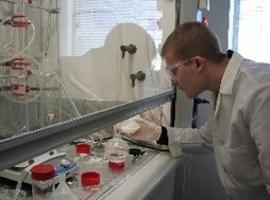
Nelson Elbers
Hometown: Baltimore, MD
Degree: MS
Major: Polymer Chemistry
Current Project: Polymer-based personalized nanomedicines for the targeted treatment of cancer
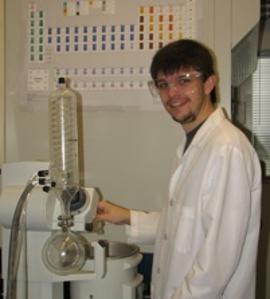
Dagen Worthington
Hometown: Webb City, MO
Degree: BS
Major: Chemistry
Current Project: Exploring soybean in the field of medicine
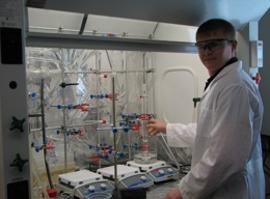
Blaze Heckert
Hometown: Pittsburg, KS
Degree: BS
Major: Biology
Current Project: One-step PAMAM-like dendrimer synthesis: Novel drug delivery system targeting cancers
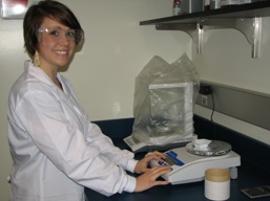
Kalee Woody
Hometown: Bronaugh, MO
Degree: BS
Major: Biology
Current Project: Magnetic nanosensors for the early detection of infectious diseases

Brittany Mundy
Hometown: Jasper, MO
Degree: BS
Major: Chemistry
Current Project: Activatable nanoprobes targeting breast cancer
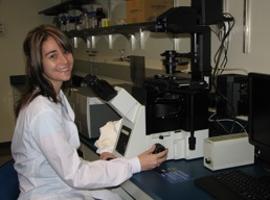
Deaven Thompson
Hometown: Pittsburg, KS
Degree: BS
Major: Biology
Current Project: Polymeric nanotheranostics for the inhibitor-induced treatment of breast cancers
Student Achievements
- 2014: K-INBRE Star-Trainee Award to Blaze Heckert
- 2014: PSU UG Best Oral Presentation (1st place) Award to Kalee Woody
- 2014: William & Mary Fern Souder Scholarship to Dagen Worthington
- 2014: PSU UG Best Poster Presentation (3rd place) Award to Blaze Heckert
- 2014: K-INBRE Semester Scholar Award to Kalee Woody
- 2014: PSU Chemistry Best UG Research Award to Blaze Heckert
- 2014: PSU Chemistry Graduate Teaching Award to Nelson Elbers
- 2014: PSU UG Best Poster Presentation (2nd place) Award to Kalee Woody
- 2014: K-INBRE Semester Scholar Award to Deaven Thompson
- 2013: K-INBRE Semester Scholar Award to Blaze Heckert
- Recent publication in Nature Communications, 2014.
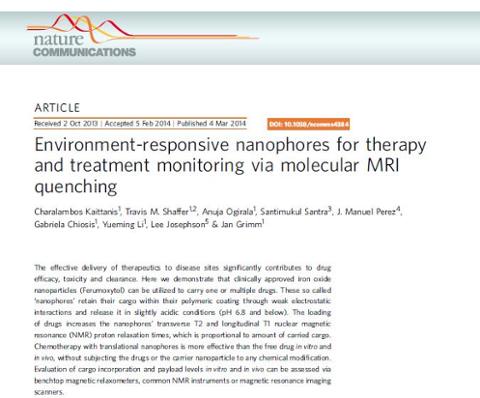
2. Our cancer research highlighted as a COVER story in the University’s FALL-2014 magazine and in the local newspapers.
Important Web Links:
a) Fall 2014 PttState Magazine - The Magic of Nano-Medicine (Online Version)
b) The Magic of Nano-Medicine - Pittsburg State University (YouTube)
c) Pittsburg State researcher working on targeted cancer treatments (Joplin Globe)
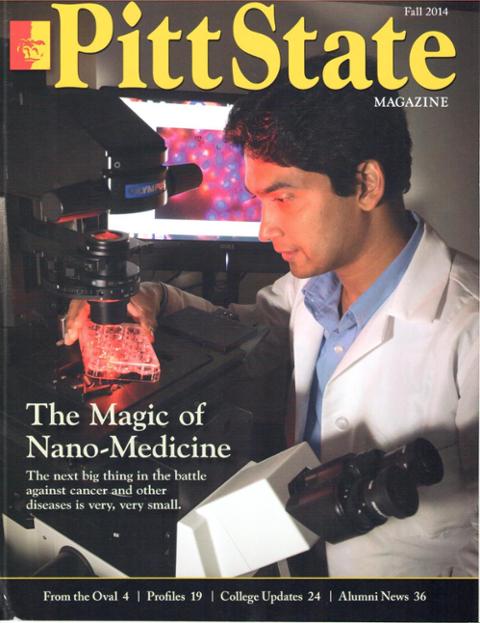
3. Outstanding Research Awards and Appreciation
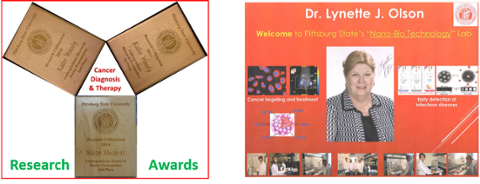
4. Service Recognition
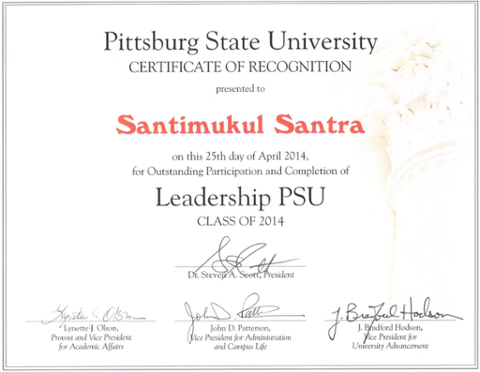
5. Activity snap shots
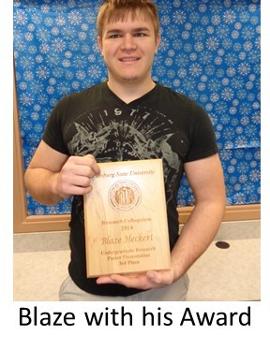
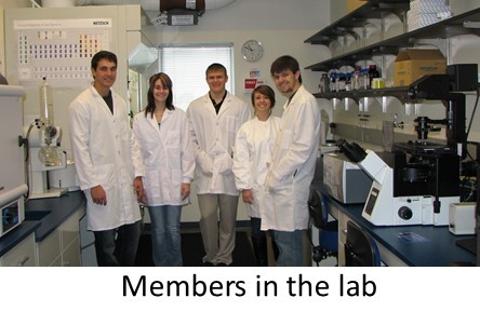

A. FACILE, ONE-STEP, SELECTIVE N-ALKYLATION OF AMINO ACIDS: Novel polymeric drug delivery system for the treatment of cancer. Published in Biomacromolecules 2011, 12, 3917.
Novel one-step methodology for selective mono and di- N-alkylation of various amino acids, without using conventional multi-step protection and deprotection methods. The newly developed one-step synthetic strategy was used for the one-step synthesis of amino acid-based small molecules, biopolymers and theranostic polymeric nanoagents. The fabricated theranostic nano-vehicle was efficient in encapsulating and delivering therapeutic drugs and dyes to the tumors. The results successfully proven the ability to target and killing of lung (A549 cells) and prostate cancers (LNCaP and PC-3 cells).
In vivo experiments showed the accumulation of glutamated- and folate-decorated DiR dye encapsulating polymeric nanoparticles in PSMA positive PC-3 tumor in mice. Increased uptake is observed for all time points in the PSMA-positive PC3-PSMA tumor.
Figure. Novel polymeric nano-vehicle for the detection and treatment of lung and prostate cancers.
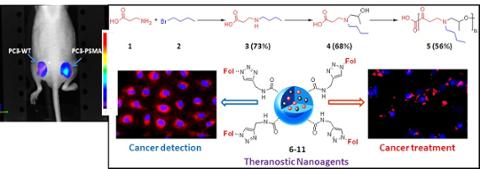
B. Step-wise organic synthesis of biocompatible hyperbranched polymers and therapeutic drug encapsulating nanoparticles and nanocomposites for the treatment of CANCER. Published in Molecular Pharmaceutics 2012, 9, 2080, Langmuir 2010, 26, 5364, Chemical Communications 2004, 2126.
Novel functional hyperbranched polymers were synthesized using simple organic chemistry and utilized for the synthesis of a biocompatible HBPE polymer. The polymer’s globular structure with functional surface carboxylic groups and hydrophobic cavities residing in the polymer’s interior allows for the formation of multifunctional polymeric nanoparticles, which are able to encapsulate a diversity of hydrophobic cargos. Solvent diffusion method and click chemistry has been followed for the synthesis of targetable functional nanoparticles and nanocomposites. These polymeric nanocomposites showed excellent magnetic, fluorescent, MRI imaging, x-ray contrast and catalytic activity when conjugated with dye encapsulating HBPE nanoparticles, iron oxide and cerium oxide nanoparticles. This offers the possibility to create novel multifunctional materials composed of hyperbranched polymeric nanoparticles with unique properties that can be tailored by the nature of their cargo, their surface functionality and the formation of supramolecular assemblies. Specifically, we examined the cytotoxic properties of a novel peptide, CT20p, derived from the C-terminal, alpha-9 helix of Bax, an amphipathic domain with putative membrane binding properties. The amphipathic nature of CT20p allowed it to be encapsulated in polymeric nanoparticles (NPs) that have the capacity to harbor targeting molecules, dyes or drugs. The resulting CT20p-NPs proved an effective killer, in vitro, of colon and breast cancer cells, and in vivo, using a murine breast cancer tumor model.
Figure. Designer dendritic polymer synthesis with hydrophobic interior, encapsulating various cargos and showed excellent magnetic, fluorescent, X-ray, MRI imaging of cancers.
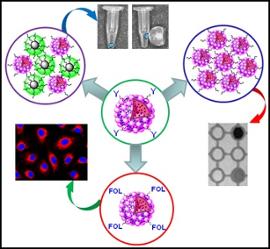
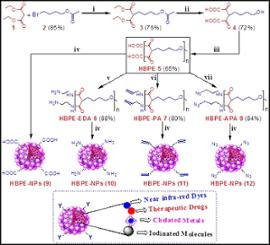
C. Novel Bifunctional System for targeted delivery of therapeutic membrane-impermeable proteins and peptides to tumors and imaging of cancer therapy. Published in Molecular Pharmaceutics 2011, 7, 1209. A water-soluble hydrophilic hyperbranched polymer has been designed for the encapsulation of water-soluble drugs doxorubicin, cytochrome C and other proteins inside the polymers’ amphiphilic nanocavities (HBPH-NPs), for the effective detection and treatment of cancer. We formulated theranostic polymeric nanoparticles for the simultaneous encapsulation of a apoptosis-initiating protein Cytochrome c and a near infrared dye ICG to folate-expressing cancer cell cells. The potential therapeutic property of these nanoparticles was demonstrated by the induction of apoptosis upon intracellular delivery. Considering that these theranostic nanoparticles can carry an endogenous cellular apoptotic initiator (Cytochrome c) and a fluorescent tag (ICG) commonly used in the clinic, their use and potential translation into the clinic is anticipated, facilitating the monitoring of tumor regression.
Figure. Water-soluble hyperbranched polymer as a biocompatible nano-carrier for anti-cancer drugs and proteins. IVIS imaging of targeting Lung cancer cells labeled with near infra-red dye ICG.
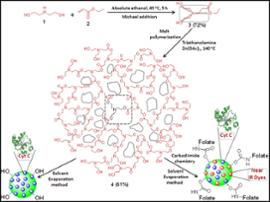
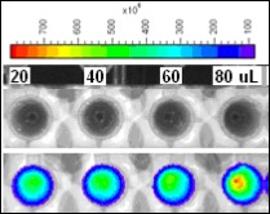
D. Multi-step organic synthesis of biodegradable dendrimers, capable of encapsulating therapeutic drugs: A new frontier in the synthetic dendrimer-based drug delivery system for ovarian cancer treatment.
Facile synthesis of 3rd generation polyurethane dendrimer involves more than 10 steps organic synthesis with several air and moisture sensitive reactions. The O-alkylation of Bis-MPA was performed for the first time without forming the cyclic bi-products. Convergent growth approach used to synthesize the dendrimer. The use of acyl azide approach has many salient features such as a) quantitative in situ thermal deprotection of the acyl azide to generate the reactive isocyanate functionality; b) the side product for the thermal deprotection step is the gaseous nitrogen and c) tolerance to allyl surface functional groups making it easier to synthesize various dendrimers with different surface functionality. The synthesized water-dispersed dendrimer nanoparticles were found to be non-toxic when treated with human ovarian cancer cells. The nanoparticles were capable of encapsulating therapeutic anti-cancer drugs; doxorubicin, benomyl, BEZ235 inhibitor and paclitaxel and optical dyes; DiI, DiR for the targeted detection and treatment of ovarian cancers. Surface functional groups were easily available to create a library of targetable theranostic dendrimer-based drug delivery systems, to prevent killing healthy tissues.
Figure. Selective synthesis of O-alkylated small molecules, utilized for the synthesis of dendrimer-based nanoparticles for the targeted treatment of ovarian cancer. HPLC traces showing the purity upto 4th generation dendrimers (G1-G4).
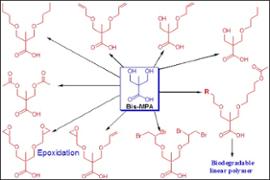
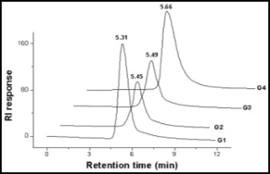
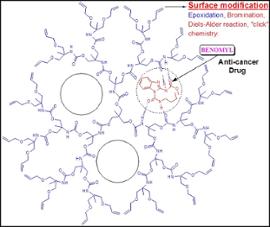
A. Small molecule-based activatable prodrugs for the detection and treatment of lung cancer. Published in JACS 2011, 133, 16680.
Design and synthesis of a glutathione activatable fluorescent prodrug for dual targeted imaging and treatment of Lung Cancer. The synthesized new probe consists of the therapeutic drug Doxorubicin and receptor targeting ligand Folate. We discovered that the cytotoxicity and fluorescence property of Doxo are quenched (OFF state) when connected with Folic acid. The probe with the disulfide linker (Figure 1A and 1C, Doxo-S-S-Fol) gets activated (ON state) by the intracellular glutathione (GSH), leading to fluorescence emission (optical imaging) and target-specific cytotoxicity (cancer treatment). In contrast, the non-cleavable probe Doxo-C-C-Fol remains quenched showing no migration to the nucleus and therefore no toxicity to the cancer cells. Results also confirmed that the sustained cytotoxicity of the released Doxo-SH derivative is compared to free Doxo. In our novel design, the folic acid acted as both a targeting ligand for the folate receptor as well as a quencher for doxorubicin’s fluorescence. Finally, the excellent plasma stability of the disulfide linker would make our activatable Doxo-S-S-Fol probe suitable in clinical settings.
Figure. Schematic diagram of the novel activatable prodrug for the targeted detection and treatment of A549 cells (Lung cancer). FACS results showed fluorescence activation upon GSH-mediated cleavage of disulfide linker and then induced apoptosis of Lung cancer cells.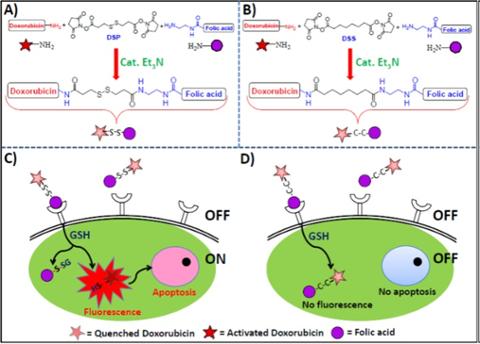
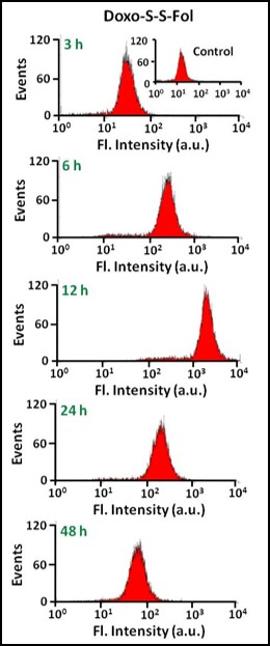
B. Activatable magnetic nanoprobes for the targeted MR Imaging and treatment of cervical cancer. Published ACS Nano 2012, 6, 7281.
I have applied my organic synthesis expertise to develop a novel gadolinium-encapsulating iron oxide nanoparticle-based activatable NMR/MRI nanoprobe for the targeted detection and treatment of acidic tumors. Developed a magnetic nanoprobe, where the Gd’s T1 magnetic relaxation is quenched by iron oxide core, a strong T2 agent. After receptor-mediated internalization, the probe becomes MRI active due to the release of Gd-DTPA complex and subsequently, the released drug used for the treatment of cancer. Our results also demonstrated that the folate-receptor mediated internalization and the subsequent lysosomal acidic pH-induced intracellular release of Gd-DTPA complex resulted in an enhanced 1/T1 MR signal. This new activatable technology will bring sophisticated tools for the in vivo MR Imaging of acidic tumors while visualizing the drug’s homing. Confocal images showed the internalization (A) and killing (B) of human cervical cancers.
Figure. Schematic representation of the acidic pH-mediated activation of the activatable composite magnetic nanoprobe IO-PAA-Gd-DTPA and corresponding T1-MRI activation. Inset: In Vivo imaging (FMT) of induced cervical cancer
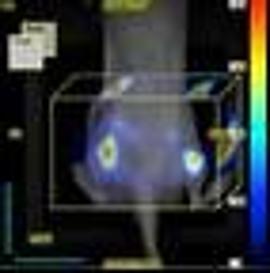
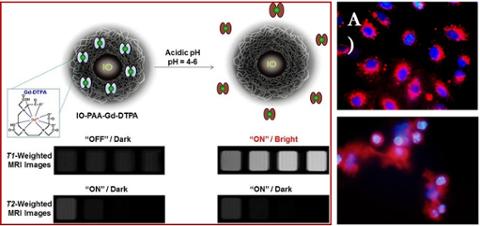
C. Environment-responsive nanophores for therapy and treatment monitoring via molecular MRI quenching. Published in Nature Communications, 2014.
The effective delivery of therapeutics to disease sites significantly contributes to drug efficacy, toxicity and clearance. Here, we used the clinically approved iron oxide nanoparticles (Ferumoxytol) that can be utilized to carry one or multiple drugs. These so called ‘nanophores’ retain their cargo within their polymeric coating through weak electrostatic interactions and release it in slightly acidic conditions (pH 6.8 and below).

The loading of drugs increases the nanophores’ transverse T2 and longitudinal T1 nuclear magnetic resonance (NMR) proton relaxation times, which is proportional to amount of carried cargo. Chemotherapy with translational nanophores is more effective than the free drug in vitro and in vivo, without subjecting the drugs or the carrier nanoparticle to any chemical modification. Evaluation of cargo incorporation and payload levels in vitro and in vivo can be assessed via benchtop magnetic relaxometers, common NMR instruments or magnetic resonance imaging scanners.
D. THERANOSTIC IRON OXIDE NANOPARTICLES AS DRUG DELIVERY SYSTEM. Targeted detection, MR Imaging and treatment of cancer. Published in Small 2009, 5, 1862.
A biocompatible, multimodal and theranostic functional IONPs was synthesized using a novel water-based method and exerted excellent properties for targeted cancer therapy, optical and magnetic resonance imaging (MRI). For the first time, a facile, modified solvent diffusion method is used for the co-encapsulation of both an anti-cancer drug and near infrared dyes. The resulting folate-decorated theranostic nanoparticles could allow for targeted optical/MR-imaging and targeted killing of folate-expressing cancer cells. We anticipate that this multimodal (magnetic and fluorescent) and multifunctional (imaging and therapeutic) IONPs will open many exciting opportunities for the targeted delivery of therapeutic agents to tumors. In addition, the dual optical and magnetic properties of the synthesized nanoparticles will allow for the dual fluorescence- and MR-based imaging and monitoring of drug efficacy. All these positive attributes make our IONPs a promising drug delivery vehicle for further in vivo evaluation.
Figure. Novel theranostic magnetic nanoparticle (left), Maestro imaging of labeled cells (right), confocal images showing the internalization (bottom-right, E) and cell death (F), and T2-mapped MRI imaging (bottom).
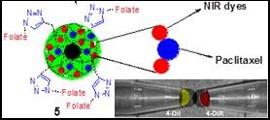
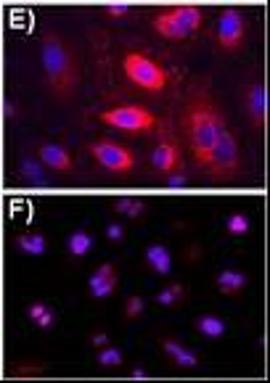
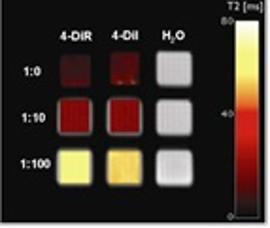
A. MAGNETIC RELAXATION-MEDIATED DETECTION AND ISOLATION OF SINGLE CERCULATING CANCER CELLS IN COMPLEX MEDIA. Published in JACS 2009, 131, 12780.
Magnetic relaxation technique (using magnetic relaxometer from Bruker, bench-top MRI, 0.47 T) was used to detect single cancer cell from blood circulation, using surface engineered magnetic nanomaterials. Similar techniques were used to trace amount of bacteria and other pathogens in milk. Herein, we study the effect of multivalency on the detection profile of cancer cells and bacteria in complex media, like blood and milk. In these studies, we conjugated folic acid at two different densities (low-folate and high-folate) on polyacrylic-acid-coated iron oxide nanoparticles and studied the interaction of these nanosensors with cancer cells expressing the folate receptor, using confocal microscopy, dynamic light scattering and magnetic relaxation. Results showed that the multivalent high-folate magnetic relaxation nanosensor performed better than its low folate counterpart, achieving single cancer cell detection in blood samples. However, the novel diagnostic typically involves the targeting ligand conjugation to create a sensitive and specific nanosensor that can bind and detect the presence of a target, such as bacterium, cancer cell, protein or a DNA sequence. We anticipate the broader use of our technology in the clinic and in the field, expediting diagnosis and decision-making in cancer.
Figure. Magnetic relaxation nanosensor-based detection, isolation and treatment of cancer.
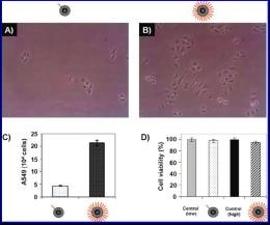
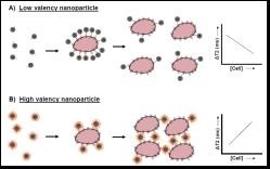
B. MAGNETIC NANOSENSOR-MEDIATED DETECTION OF INFECTIOUS DISEASES. Published in JACS 2011, 133, 3668, Bioconjugate Chemistry, 2011, 22, 307, PLoS One 2012, 7, e35326.
Organic chemistry-based, surface engineered magnetic resonance nanosensors (MRnS) were used for the first time to detect cholera toxins, Anthrax Lethal Factors, pathogens for crohn’s and jones diseases, MAP bacteria and other infectious diseases. These works highlighted all over the USA through the NIH and other websites and multiple media channels. Bacterial infections are still a major global healthcare problem. The quick and sensitive detection of pathogens responsible for these infections would facilitate correct diagnosis of the disease and expedite treatment. Of major importance are intracellular slow-growing pathogens that reside within peripheral leukocytes, evading recognition by the immune system and detection by traditional culture methods. Herein, we report the use of hybridizing magnetic nanosensors (hMRS) for the detection of an intracellular pathogen, Mycobacterium avium spp. paratuberculosis (MAP). The hMRS with unique genomic sequence, acting as proximity magnetic relaxation nanosensors, resulting in an increase in magnetic relaxation of surrounding water molecules upon hMRS binding to their target. Demonstrated that the change in magnetic relaxation is associated with the interaction of the nanoparticles with ligands. MRnS induce large increases in the relaxation signal upon binding to a target, whereas when the target promotes nanoparticle clustering the signal decreases. This technology was also used to target, isolate and treatment of Cholera toxin B-subunits, employing molecular mimicry, robust ganglioside-resembling iron oxide nanoparticles, via changes in spin-spin relaxation times (ΔΤ2) and achieved detection sensitivity in the low picomolar regime (40 pM).
Figure. Hybridized magnetic nanosensors (hMRS, from the top) showed the effective detection and isolation of pathogens in blood within an hour, compare to the traditional culture-based nPCR (12 weeks) or direct nPCR (24 h). Images showing the principle of MRnS as nanosensors and the molecular mimicry for the detection of cholera toxins.
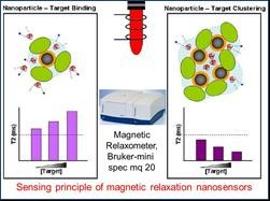
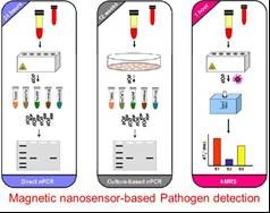
A. Introducing Oxidase-like activity of Cerium-oxide nanoparticles as an effective nanocatalyst and detection tool in immunoassays and its cytotoxicity towards the treatment of malignant carcinomas. Published in Angewandte Chemie 2009, 48, 2308, ACS Nano 2010, 4, 5321.
Our research discovered the auto-catalytic properties and oxidase-like activity of nanoceria. We found that the nanoceria has an intrinsic oxidase-like activity at different acidic pH and it can quickly oxidize a series of organic substrates without using any oxidizing agents, such as, hydrogen peroxide. Interestingly, we also noticed that the observed activity is not only pH dependent but is also depends on the size of the nanoceria and thickness of the polymeric coatings. This oxidase-like activity makes potentially useful as aqueous redox catalysts for the oxidation of water pollutants and TMB-based immunoassays. Our research showed that nanoceria was able to oxidise organic dyes TMB, AzBTS and DOPA in acidic condition, without the addition of any oxidizing agent. We hypothesized that the nanoceria-based detection approach would be more robust than current HRP-based assays (ELISA), as no enzyme, antibodies or hydrogen peroxide would be needed for detection. Therefore, nanoceria-based immunoassay to identify the presence and concentration of a target will be faster and cheaper than using traditional ELISA.
Figure. Oxidase-like activity of synthesized nanoceria. Effective oxidation of organic dyes in acidic media without using any oxidizing agents. Comparison between traditional ELISA and nanoceria-based ELISA: In our nanoceria-based ELISA, the oxidase activity of nanoceria facilitates the direct oxidation of TMB without the need of HRP or H2O2. 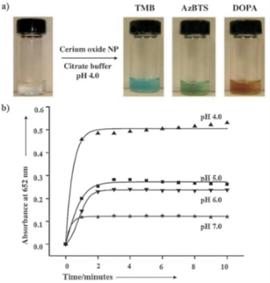
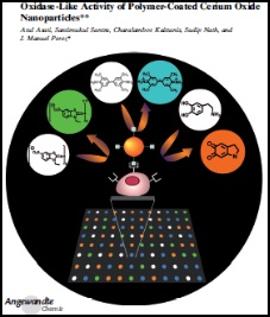
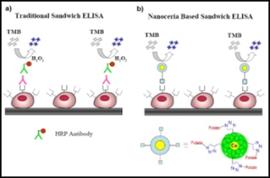
B. Nanoceria-based medical device for the detection of chronic inflammations and cancer biomarkers via optical and MR Imaging. Published in Nanoscale 2012, 4, 2117. Analytical Chemistry 2011, 83, 2547.
We have developed a nanoceria-based device that can detect abnormal levels of hydrogen peroxide and micro-environmental alterations through changes in the device’s fluorescence and magnetic resonance signals. Considering that nanoceria can sequester other forms of ROS, such as superoxide and nitroxyl radicals, the device can potentially sense a plethora of inflammatory mediators, other than hydrogen peroxide. For medical applications, this system can be utilized as a standalone implantable device or prosthetic equipment’s component. For instance, it can have applications in a broad range of ailments with a pro-inflammatory component, including inflammatory bowel disease, ulcerative colitis, cystic fibrosis, sepsis, cardiovascular disease, arthritis, multiple sclerosis and Alzheimer’s. Furthermore, as acidosis and ROS interfere with cancer chemotherapy, the device can be utilized as an implant in cancer therapeutic regimes. Additionally, patients with transplants or prosthetic apparatuses may utilize the nanoceria-based device for the in vivo monitoring of the post-operative inflammatory response, as the device can be further miniaturized and integrated to the prosthetic organ.
Figure. The device reports the presence of aberrant levels of inflammation through the changes in fluorescence emission and MRI signal (T2). Photograph of nanoceria-based device and conceptual diagram of its performance in different clinical conditions. Under physiological conditions, fluorescence emission is high, whereas the MRI signal (T2) is low. However under inflammatory conditions, fluorescence emission decreases, while the MRI signal (T2) increases.
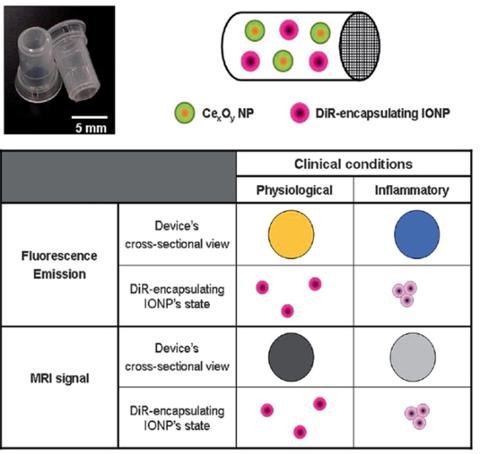
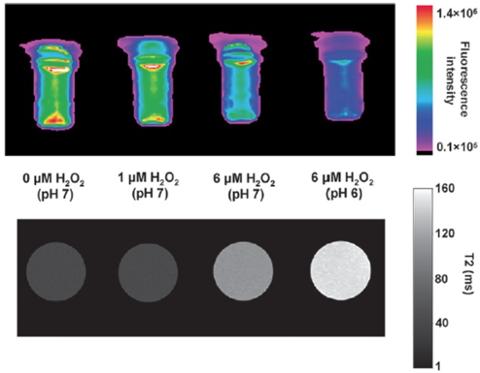
- J. M. Perez, S. Santra. “Gadolinium-Encapsulating Iron Oxide Nanoprobe as Activatable NMR/MRI Contrast Agent" US Patent Appl. No. 61668622.
- J. M. Perez, S. Santra. “Synthesis of hyperbranched amphiphilic polyester and theranostic nanoparticles thereof.” US Patent # 8,372,944 B1.
- J. M. Perez, S. Santra. “Multimodal, Mutifunctional Polymer Coated Nanoparticles” US Patent # 8,236,284 B1.
- J. M. Perez, A. Asati, S. Santra, C. Kaittanis “Surface Charge Dependent Cell Localization and Cytotoxicity of Cerium Oxide Nanoparticles” U.S. patent Appl. 61/366,697.
- J. M. Perez, A. Asati, S. Santra, C. Kaittanis, S. Nath “Oxidase activity of polymer coated cerium oxide nanoparticles” U.S. patent Appl. 61/160,744.
- J. M. Perez, C. Kaittanis, A. Asati, S. Santra. “A cerium-oxide-nanoparticle-based device for the detection of reactive oxygen species and monitoring of chronic inflammation” U.S. patent Appl. 12/924,976.
- Santra, S. Kumar, A. et. al., "Malonic acid based monomers and polymers" Indian Patent Appl. 664/ MUM/2006.
- Santra, S. Kumar, A. et al.,"N-alkylation of amino acids and their application in polymer synthesis" Indian Patent Appl. 775/MUM/2006.
- Santra, S. Kumar, A. et. al., “O-alkylation of β, β-disubstituted hydroxyl compounds and its applications in polymer syntheses” Indian Patent Appl. 776/MUM/2006.
Peer Reviewed Publications
Total Cumulative Impact Factor >150, Total Citations > 600, and few more manuscripts are under preparation.
- C. Kaittanis, T. M. Shaffer, A. Ogirala, S. Santra, J. M. Perez, G. Chiosis, Y. Li, L. Josephson, J. Grimm. “Environment-responsive nanophores for therapy and treatment monitoring via molecular MRI quenching” Nature Communications 2014, 5:3384 doi: 10.1038/ncomms4384 (online). (I.F. 10.01)
- Santra, S. Jativa, D. J. Kaittanis, C. Normand, G. Grimm, J. Perez, J. M. “Gadolinium-Encapsulating Iron Oxide Nanoprobes as Activatable NMR/MRI Contrast Agent” ACS Nano 2012, 6, 7281. (I.F. 12.06)
- Boohaker, R. Zhang, G. Lee, M. Nemec, K. Santra, S. Perez, J. Manuel; Khaled, A. "Rational Development of a Cytotoxic Peptide to Trigger Cell Death" Molecular Pharmaceutics 2012, 9, 2080-2093. (I.F. 4.57)
- C. Kaittanis, H. Boukhriss, S. Santra, J. F. Valentine, S. A. Naser, J M. Perez. “Hybridizing magnetic relaxation nanosensors facilitate the rapid and sensitive detection of an intracellular pathogen in human peripheral leukocytes” PLoS One, 2012, 7, e35326. (I.F. 4.4)
- *Featured in Genetic Engineering and Biotechnology NewsMagazine. *Featured in www.nano.gov website of National Nanotechnology Initiative group. *Posted on National Institute of General Medical Science (NIH) website. *Posted on Sciencedaily.com website. *Posted on Europapress.com website. *Posted on Eurekalert.com website. *Posted on today.ucf.com website. *Interviewed on FOX 35 news channel.
- C. Kaittanis, S. Santra, A. Asati, J. M. Perez. “A Cerium Oxide Nanoparticle-based Device for the Detection of Chronic Inflammation via Optical and Magnetic Resonance Imaging” Nanoscale 2012, 4, 2117-2123. (I.F. 6.23)
- S. Santra, C. Kaittanis, O. J. Santiesteban, J. M. Perez “Cell-Specific, Activatable and Theranostic Prodrug for Dual Targeted Cancer Imaging and Therapy” J. Am. Chem. Soc. 2011, 133, 16680-16688. (I.F. 10.67)
- S. Santra, C. Kaittanis, O. J. Santiesteban, J. M. Perez “Trifunctional Targeting” ACS Chem. Biol. (Spotlight), 2011, 6, 1143-1143. (I.F. 6.44)
- S. Santra,* J. M. Perez “Facile, One-Step, Selective N-Alkylation of Amino Acids: Novel Polyamino Acid-Based Theranostic Nanoagents for Targeted Cancer Therapy” Biomacromolecules 2011, 12, 3917-3927 (I.F. 5.47). * Corresponding Author.
- C. Kaittanis, S. Santra, O. J. Santiesteban, T. Henderson, J. M. Perez “The Assembly State between Magnetic Nanosensors and their Targets Orchestrates their Magnetic Relaxation Response” J. Am. Chem. Soc. 2011, 133, 3668-3676. (I.F. 10.67)
- A. Asati, C. Kaittanis, S. Santra, J. M. Perez. “pH-Tunable Oxidase-Like Activity of Cerium Oxide Nanoparticles Achieving Sensitive Fluorigenic Detection of Cancer Biomarkers at Neutral pH” Anal. Chem. 2011, 83, 2547-2553. (I.F. 5.69)
- C. Kaittanis, T. Banerjee, S. Santra, O. J. Santiesteban, K. Teter, J. M. Perez. “Identification of Molecular-Mimicry-Based Ligands for Cholera Diagnostics using Magnetic Relaxation” Bioconjugate Chemistry, 2011, 22, 307-314. (I.F. 5.37)
- A. Asati, S. Santra, C. Kaittanis, J. M. Perez. “Surface chemistry-dependent cell localization and cytotoxicity of cerium oxide nanoparticles” ACS Nano, 2010, 4, 5321-5331. (I.F. 12.06)
- S. Santra, C. Kaittanis, J. M. Perez. “Cytochrome c Encapsulating Theranostic Nanoparticles: A Novel Bifunctional System for targeted delivery of therapeutic membrane-impermeable proteins to tumors and imaging of cancer therapy” Molecular Pharmaceutics, 2010, 7, 1209-1222. (I.F. 4.57)
- Kaittanis, C., Santra, S., Perez, J. M. Emerging nanotechnology-based strategies for the identification of microbial Adv. Drug Deliv. Rev. 2010, 62, 408. (I.F. 12.88)
- Santra, S., Kaittanis, C., Perez, J. M. Aliphatic Hyperbranched Polyester: A New Building Block in the Construction of Multifunctional Nanoparticles and Nanocomposites. Langmuir 2010, 26, 5364. (I.F. 4.18)
- Santra, S., Kaittanis C., Grimm J. and Perez J. M. Drug/Dye-Loaded, Multifunctional Iron Oxide Nanoparticles for Combined Targeted Cancer Therapy and Dual Optical/MR-Imaging, Small 2009, 5, 1862. (I.F. 8.34) *Posted on National Institute of General Medical Science (NIH) website *Invited for an interview in TV media coverage. *Posted on Sciencedaily.com website.
- Asati, A., Santra, S., Kaittanis, C., Nath, S., Perez, J. M. Oxidase-like activity of polymer-coated cerium oxide nanoparticles. Angew. Chem. Int. Ed. Engl. 2009, 48, 2308. (I.F. 13.45)
- *Featured as very important paper *Selected for cover picture of the journal *Featured in ACS Chemical & Engineering News Magazine *Invited by ACS Communication office for Media coverage *Posted on National Institute of General Medical Science (NIH) website.
- Kaittanis, C., Santra. S., Perez, J. M. Role of nanoparticle valency in the nondestructive magnetic-relaxation-mediated detection and magnetic isolation of cells in complex media. J. Am. Chem. Soc. 2009, 131, 12780. (I.F. 10.67)
- S. Santra and A. Kumar. “Facile synthesis of aliphatic hyperbranched polyesters based on diethylmalonate and their irreversible molecular encapsulation” Chem. Comm. 2004, 2126. (I.F. 6.37)
- A. Kumar, A. Q. Contractor, A. V. Ambade, T. Ranganathan, K. Krishnamoorthy, S. P. Mishra, U. P. Ojha, S. Santra, M. Kanungo “Novel approaches for novel materials” Int. J. Plast. Tech. 2003, 6, 73.
Reviewer of the following journals
- ACS Applied Materials & Interfaces (Invited)
- Langmuir (Invited)
- Colloids and Surfaces B: Biointerfaces (Invited)
- Journal of Nanoparticle Research (Invited)
- Molecules (Invited)
- IEEE Transactions on Information Theory (Invited)
- International Journal of Nanomedicine (Invited)
- Current Nanoscience (Invited)
Reviewer of the following research grants
- Research proposal/grant reviewed for Swiss National Science Foundation (Invited)
Awards and Honors
- 2012-2012 - Best Oral Presentation Award, NanoFlorida Symposium 2012, USF, Tampa.
- 2010-2011 - Recognition from American Chemical Society for substantial contribution as author and reviewer.
- 2010-2010 - Best Poster Presentation Award, NanoFlorida Symposium 2010, UCF, Orlando.
- 2009-2009 - Recognition in ACS Chemical & Engineering News (C&EN) magazine.
- 2003-2006 - Senior Research Fellow (SRF) Award: National Eligibility Test- Council of Scientific and Industrial Research (NET-CSIR), India.
- 2001-2003 - Junior Research Fellowship (JRF) Award: National Eligibility Test- Council of Scientific and Industrial Research (NET-CSIR), India.
Professional Affiliations
- 2009-Present - Member, American Chemical Society (ACS)
Selected Conference Proceedings and Presentations
- “Designer Polymeric Nanotheranostics for the Detection and Treatment of Cancer” K-INBRE conference at Kansas City, MO, Jan 17-18, 2014 (Poster).
- “In the Age of Polymer Science: Polymeric “Nano-Bio” Theranostics to Solve the Environmental and Human Health Problems” ACS MWRM conference at Springfield, MO, Oct 16-19, 2013 (Invited speaker).
- “Gadolinium-Encapsulating Iron Oxide Nanoprobes as Activatable NMR/MRI Contrast Agent” NanoFlorida Symposium 2012 (Best Oral Presentation Award winner).
- “Nanoparticles in Imaging Technologies” NSTI Nanotech, Boston, MA, June 2011 (Oral presentation).
- “Biodegradable hyperbranched polyester: A new building block in the construction of multifunctional nanoparticles and nanocomposites for targeted cancer therapy and imaging” The 239th American Chemical Society National Meeting and Exposition at San Francisco, California, March 2010 (Oral presentation).
- “Aliphatic Hyperbranched Polyester: A New Building Block in the Construction of Multifunctional Nanoparticles and Nanocomposites” NanoFlorida Symposium 2010 (Best Poster Presentation Award winner).
- “Single reagent based immunoassay for the detection of cancer biomarkers and cancer cell” The 238th American Chemical Society National Meeting and Exposition at Washington DC, August 2009 (Oral presentation).
- “Polymer coated cerium oxide nanoparticles as antioxidant and its oxidase like activity” 7th AAPS National Biotechnology Conference 2009 (Invited talk and Poster).
- “pH modulated enzymatic behavior of cerium oxide nanoparticles and its potential application in cellular ELISA” NanoFlorida Symposium 2009 (Poster).
- “Intrinsic oxidase activity of cerium oxide nanoparticles facilitate the detection of cancer biomarkers and cancer cells” NSTI-Nanotech 2009, ISBN 978-1-4398-1783-4 Vol. 2 (Oral presentation).
- “Unique pH-dependent free radical scavenging activity of dextran coated cerium oxide nanoparticle” The 236th American Chemical Society National Meeting and Exposition at Philadelphia, August 2008 (Poster).
- “Diversity oriented polymer syntheses: Design and Syntheses of functional biopolymers” International Conference MACRO 2006 at Pune, India, December 2006 (Oral presentation).
- “Synthesis of Bis-MPA based aliphatic polyurethane homodendrimers” International Conference MACRO 2004 at Trivandrum, India, December 2004 (Poster).
- “Synthesis and characterization of hyperbranched polymers and dendrimers for biomedical applications” 6th National Symposium of Chemical Research Society of India at IIT Kanpur, India, February 2004 (Poster).
- “Synthesis and characterization of aliphatic hyperbranched polyester based on diethyl malonate and Bis-MPA” RSC-West India Section’s 1st Students Symposium at NCL-Pune, India, September 2003 (Invited Talk).
- “Synthesis and characterization of aliphatic hyperbranched polyester based on diethyl malonate” International Conference MACRO 2002 at IIT Kharagpur, India, December 2002 (Poster).
Funded Grants
- “Highly economic, one-step synthesis of soybean polyols for industrial applications”, PI, Kansas Soybean Commission, $100,000.00; 2015-2017.
- “Development of new soybean-based anti-oxidant topical lotion for skin care applications”, PI, Kansas Soybean Commission, $100,000.00; 2015-2017.
- “Polycarbonates from soybean oil based epoxides and carbon dioxide” Co-PI, Kansas Soybean Commission, $50,000.00; 2015-2016.
Pittsburg State University Start-up Fund, $200,000, PI, Received FY 2014 - 2015. - “Development of novel sulfur-containing theranostic nanomedicines for the targeted X-ray/CT imaging and treatment of cancers”, Kansas IDeA Network of Biomedical Research Excellence (K-INBRE), $25,000, PI, Funded in 2014.
- “Design and Synthesis of Novel Polymeric Nanotheranostics for the Targeted Optical / X-ray CT Imaging and Treatment of Lung Cancer” Star Trainee Award (student award), K-INBRE, $8,000, PI, Funded in 2014.
- "Assessment of Molecular Interactions for the Rapid and Sensitive Detection of Influenza using Novel Magnetic Relaxation Nanosensors" Summer Scholar Award (student award), K-INBRE, $4,000, PI, Funded in 2014.
- “Nucleolin Targeting Novel Polymeric Nanotheranostics for the MR Imaging and Treatment of Breast Cancer” Summer Scholar Award (student award), K-INBRE, $4,000, PI, Funded in 2014.